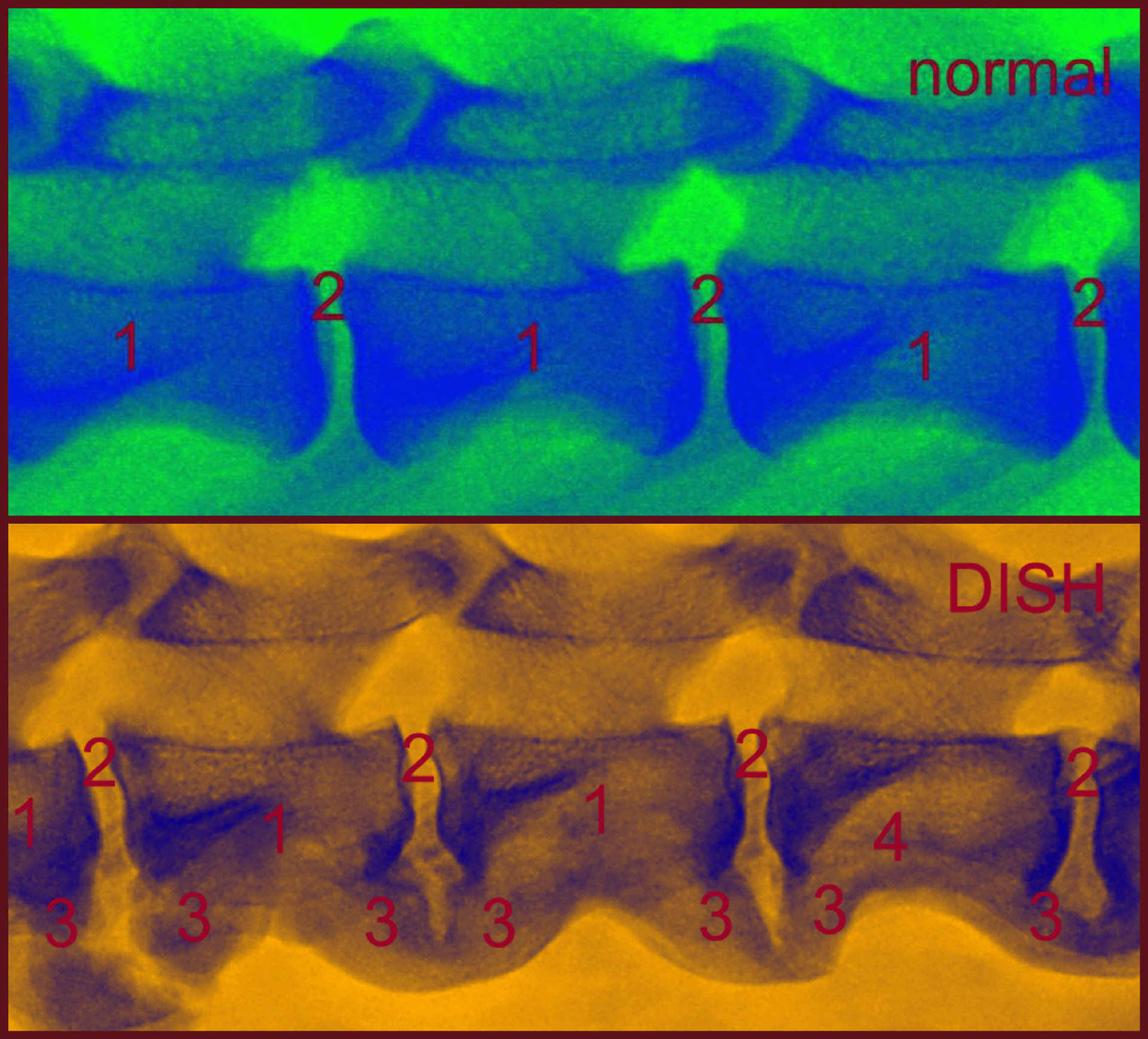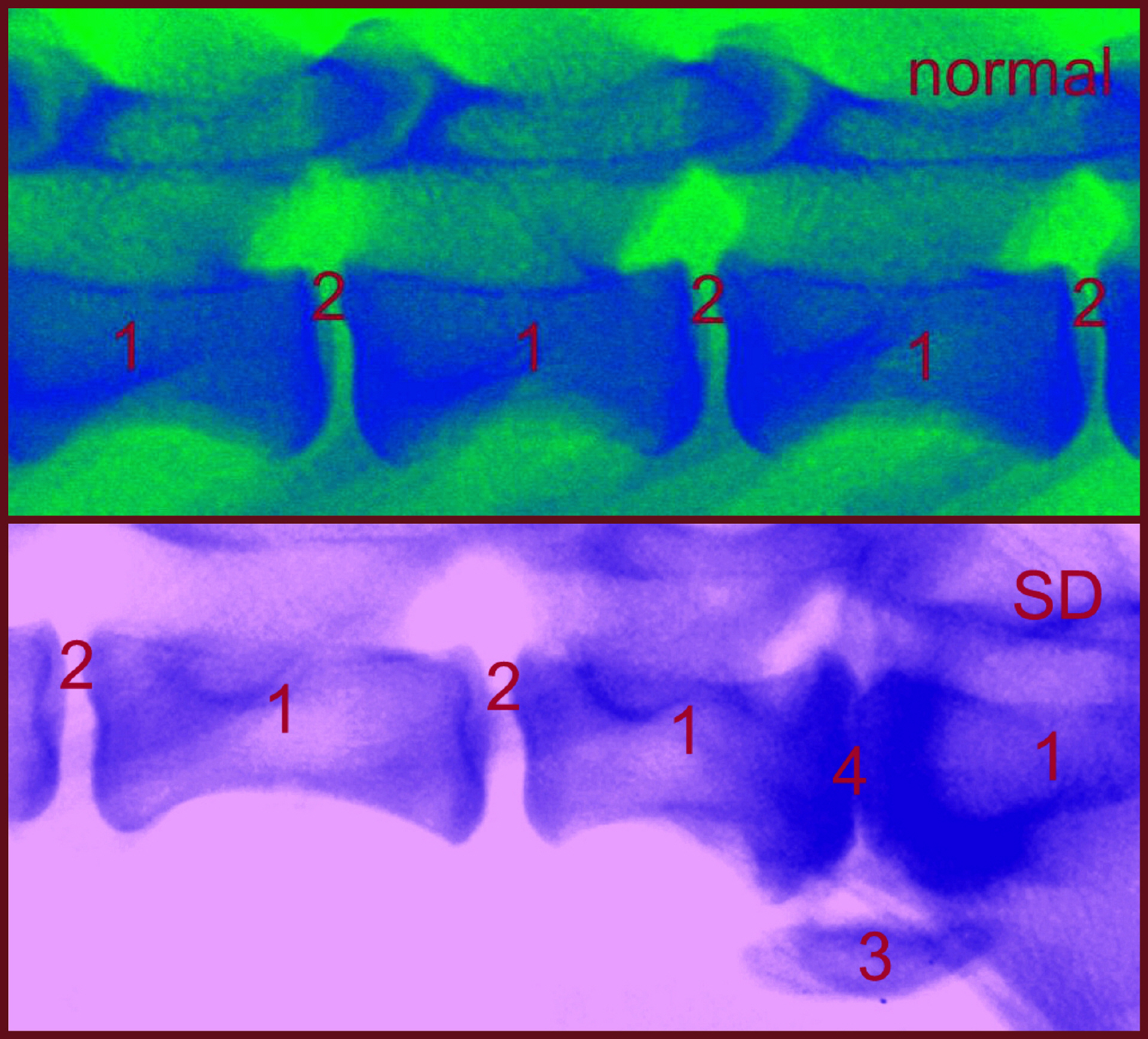DISH: A hereditary disease of the spine in Australian Cattle Dogs
This article is intended to raise awareness in breeders of Australian Cattle Dogs for a grave health problem of the spine with high heredity.
The diseases name is DISH (diffuse idiopathic skeletal hyperostosis) which roughly translates to unclear increase in bone substance without known cause .
DISH is common in ACD and until now very often underestimated or unrecognised. DISH often is confused with spondylosis (SD) the differences will be explained below.
A research project was started at Swiss University of Bern aiming to develop a gene test for DISH. Prof. Tosso Leeb is collecting blood samples of affected dogs and their relatives. X-rays of the spine are analysed and categorised by PD Dr. med. vet. F. Steffen, ECVN.
At the moment 119 blood samples are analysed. According to the x-rays they are categorised as follows:
ˇ 74 dogs free of DISH
ˇ 25 dogs affected with DISH
ˇ 11 dogs younger than 7 years uncertain
ˇ 9 dogs older than 7 years uncertain
Uncertain means that either there is only one vertebral segment with DISH or it is not possible in this case to distinguish without doubt DISH from SD.
Age of onset:
It was shown that at 15 months of age there are no signs of DISH on dogs, who were later to be diagnosed as DISH affected. The earliest signs of DISH on x-rays are probably visible from 2 years of age on or even older.
Progression of a DISH affected cattle dog male at 1 year, 2.5 years and 7 years

Mode of inheritance:
In various unrelated lines of descent, there are as many as 4 uninterrupted generations of affected dogs recorded. For every affected dog there was at least one affected parent to be found. This means DISH is most likely a dominant mode of inheritance. Dominant means: Dogs who have either one (heterozygous) or two (homozygous) defective alleles on the DISH gene locus are affected of DISH. Only dogs with two healthy alleles are free of DISH. A recessive or polygenetic mode of inheritance DISH has not yet disproved, but we hope the dominant-mode-of-inheritance hypothesis will stand true as our current data strongly supports it. Until now, there are no DISH affected dogs out of two DISH free dogs recorded. It does remain possible that there are two forms of DISH with different age of onset; therefore the sample of uncertain dogs was divided into two age groups.
Further work/cost:
The team of Prof. Tosso Leeb firstly will do a GWAS (genome wide association study). If their research is successful the results will be published in a scientific journal. From there, commercial laboratories will use the information to develop a genetic test. When asked about the cost of a research project like this, Prof. Leeb answers:
Indeed our research is quite costly. As every project is developing its own way it is hard to estimate but calculating full cost including personnel and equipment we will be in a six figure sum per gene test. This financial burden is mainly carried by swiss tax payers and by the owners and breeders of the dogs who are providing the samples. If those had to be paid by the university, there would only very little science be done anymore.
With this in mind, we would like to thank all of the owners and breeders of cattle dogs who supported this study. Without their great cooperation and commitment it would have been impossible to provide enough blood samples and x-rays. We wish the best of luck to the scientists and hope to have a gene test available for our breed soon.
Breeding advice:
From the current scientific and veterinarian views, it is strongly recommended to take x-rays of the spine before breeding a dog. Until there is a genetic test developed, the safest choice is to breed only two dogs older than 2 years old that are both free of DISH.
Because DISH was formerly completely unknown in the ACD, even specialised vets could mistake DISH for SD (spondylosis deformans). As such, we are willing to assess the spinal x-rays of your dogs, and in cases where we are uncertain, we will contact the specialist in Switzerland.
What is DISH?
DISH (diffuse idiopathic skeletal hyperostosis) is a non-inflammatory process, also known as bamboo spine .
In a DISH affected dog the spines tendons and ligaments (especially the anterior longitudinal ligament) calcify already in a young dog (even before the age of 2 years). The intervertebral spaces and the intervertebral discs are affected only very rarely.
X-rays show those calcifications have the same bone density as the vertebrae. Calcification begins in the middle of a vertebra. Sometimes a fine line is visible at the original border of the vertebra.

1 - Vertebra, 2 Intervertebral spaces with discs, 3 extreme calcification of the anterior longitudinal ligament ventral of the spine, 4 fine line
Most frequently DISH affects the lumbar spine although any other part of the spine can be affected as well. It is most infrequent in the cervical region. Interestingly DISH is extremely rare for the lumbosacral region (L7 to S1)
The cause for DISH is yet unknown although a huge genetic component is assumed. There is no reason to believe that overly exercise in young puppies would have any cause in calcification of the anterior longitudinal ligament ventral.
Clinical signs are rare in young dogs affected with DISH. A change in tail carriage, a bent or stiff spine, loss of movability, change of gait (pacing) or refusal to work in otherwise cooperative dogs can be strong indications of problems in the spine.
The amount of clinical signs is dependent of the degree of DISH (number of affected vertebrae) and the age of the dog (in aging muscle power and movability decrease, pain increases).
Dogs with clinical signs may even suffer from both diseases, DISH and SD (spondylosis deformans).
What is SD?
SD (spondylosis deformans) is a degenerative process in the vertebrae and in the intervertebral spaces and discs.
Degenerative means due to ware. Most probably the cause for SD is excessive use of the disc. In repairing small damages and stabilising overmovability the body is growing osteophytes (bone dents) to stabilise the intervertebral space.
The bone density of these calcifications is lower than in DISH and calcification growth does not start in the middle of the vertebrae. This gives a different appearance in x-rays.
Cause for SD is not entirely clear. Besides too much movement and excessive use (trauma) a genetic disposition could be playing a role as well.
Dogs with SD commonly show clinical signs. They utter noises of pain, resist to jump, are limping or even have neurological failures like loss of control of bladder and anus.
There are dogs affected from both, DISH and SD. In some cases exact diagnosis is only possible by use of MRI (magnetic resonance imaging).

1 - vertebra, 2 normal intervertebral space and disc, 3 - osteophyte (dent), 4 severely compressed intervertebral space and disc
Summary:
DISH rarely affects intervertebral spaces and discs.
DISH rarely affects L7-S1 (lumbosacral region)
SD often comes with disc problems and commonly shows clinical signs.
Literature:
A. Togni, H. J. C. Kranenburg, J. P. Morgan, F. Steffen (2014): Radiographic and MRI characteristics of lumbar disseminated idiopathic spinal hyperostosis and spondylosis deformans in dogs. J Small Anim Pract Jul 12; 55 (7):343-9. Epub 2014 Apr 12.
http://www.researchgate.net/publication/261602552_Radiographic_and_MRI_characteristics_of_lumbar_disseminated_idiopathic_spinal_hyperostosis_and_spondylosis_deformans_in_dogs
3. October 2014
Eva Holderegger Walser, Schweiz (eva@cattledog.ch)
Mag.rer.nat. Viktoria Kastner, Österreich (cattledog@pleistozaen.at)
med.vet. Maike Jahto, Deutschland (maike-jatho@t-online.de)
english translation: Viktoria Kastner (proof reading: Jen Seaborn
Text and illustrations reviewed by PD. Dr. F. Steffen, ECVN.